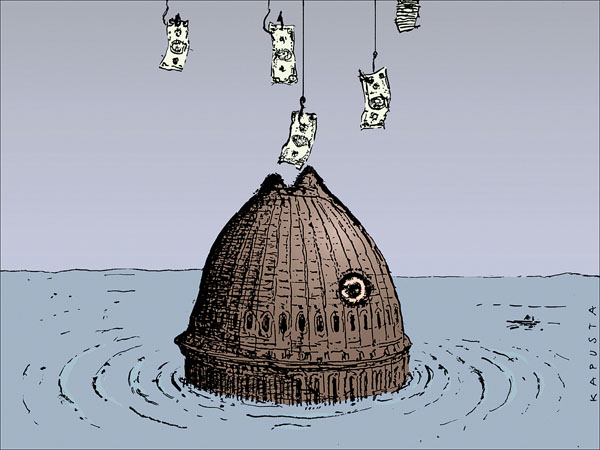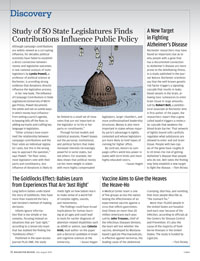Discovery
 (Photo: Corbis)
(Photo: Corbis)Although campaign contributions are widely viewed as a corrupting influence, for decades political scientists have failed to establish a direct connection between money and legislative outcomes. A new national analysis of state legislators by Lynda Powell, a professor of political science at Rochester, is providing strong evidence that donations directly influence the legislative process.
In her new book, The Influence of Campaign Contributions in State Legislatures (University of Michigan Press), Powell documents the subtle and not-so-subtle ways in which money buys influence–from setting a party’s agenda, to keeping bills off the floor, to adding earmarks and crafting key language in legislation.
“Other scholars have examined the relationship between campaign contributions and the floor votes an individual legislator casts, but this is the wrong way to approach the question,” says Powell. “On floor votes, most legislators vote with their party and constituency. Any influence of donations is likely to be limited to a small set of close votes that are not important to the legislator or to his or her party or constituents.”
Through formal models and statistical analysis, Powell teases out the personal, institutional, and political factors that make moneyed interests increasingly powerful in some states, but not others. For example, her data shows that political money carries more weight in states with more highly compensated legislators, larger chambers, and more professionalized leadership structures. Money is also more important in states whose majority party’s advantage is tightly contested and whose legislators are more likely to hold hopes of running for higher office.
By contrast, donors to campaign coffers wield less power in states with term limits and more highly educated voters.
—Susan Hagen
A New Target in Fighting Alzheimer’s Disease
Rochester researchers may have found an important clue as to why people with a gene that has a documented connection to Alzheimer’s disease are more prone to the debilitating illness. In a study published in the journal Nature, Rochester scientists say that the well-known genetic risk factor triggers a signaling cascade that results in leaky blood vessels in the brain, allowing toxic substances to enter brain tissue in large amounts.
Led by Robert Bell, a postdoctoral associate at Rochester who is first author of the paper, the researchers report that a gene called ApoE4 triggers a molecular cascade that weakens the blood-brain barrier. That network of tightly bound cells carefully regulates what substances are allowed to enter and exit brain tissue. People with two copies of the gene have roughly 8 to 10 times the risk of getting Alzheimer’s disease than people who do not. Bell notes the finding may help establish a new target to fight the disease.
—Tom Rickey
The Goldilocks Effect: Babies Learn from Experiences That Are ‘Just Right’
Long before babies understand the story of Goldilocks, they have more than mastered the fairy tale heroine’s method of making decisions. Infants ignore information that is too simple or too complex, focusing instead on situations that are “just right,” according to a University team that has dubbed the finding the “Goldilocks effect.”
Published in the open-access journal PLoS ONE, the study sheds light on how babies learn to make sense of a world full of complex sights, sounds, and movements. The findings could have broad implications for human learning at all ages and could lead to tools for earlier diagnosis of attention-related disabilities such as ADHD or autism, says Celeste Kidd, lead author on the paper and a doctoral candidate in brain and cognitive sciences at the University.
—Susan Hagen
Vaccine Aims to Give the Heaves the Heave-Ho
A Medical Center team is one of five groups across the nation testing the effectiveness of an experimental vaccine against a virus that inflicts gastrointestinal illness on more than 20 million Americans each year. Led by John Treanor, chief of the Infectious Diseases Division, the team will test whether the vaccine, developed by Montana-based LigoCyte Pharmaceuticals, is effective against norovirus, the leading cause of the abdominal cramping, diarrhea, and vomiting that most people describe as “the stomach flu.”
More than 70,000 people in the United States are hospitalized each year because of the infection, according to officials at the Centers for Disease Control and Prevention. It’s also the cause of the majority of food-borne illnesses in the United States. The study is funded by LigoCyte.
—Tom Rickey
Volcanic ‘Plumbing’ Provides Clues to Eruptions, Earthquakes N
ew studies into the “plumbing systems” that lie beneath volcanoes could bring scientists closer to understanding plate ruptures and predicting eruptions—both of which are important steps for protecting people from earthquakes and volcanic hazards. Published in Nature Geoscience, the studies by international teams of researchers, including Cynthia Ebinger, professor of geophysics, and Manahloh Belachew, a postdoctoral associate in earth and environmental sciences, indicate that the ground beneath magma chambers and rift zones starts “uplifting” for months before an eruption. The team members hope that the models they developed for measuring such activity will indicate signals that are fundamental to predicting eruptions.
The teams studied the location and behavior of magma chambers on the Earth’s mid-ocean ridge system, a vast chain of volcanoes along which the Earth forms new crust. The team built and tested computer models to measure how the ground elevated as new magma increased pressure in underground chambers.
—Peter Iglinski
Study Links PTSD to Hidden Head Injuries Suffered in Combat
Even when brain injury is so subtle that it can only be detected by an ultra-sensitive imaging test, the injury might predispose soldiers in combat to post-traumatic stress disorder, according to a Medical Center study. Published online by the Journal of Head Trauma Rehabilitation, the research may help physicians who are caring for troops in the years following deployment, as doctors try to untangle the symptom overlap between PTSD and mild traumatic brain injury and provide the appropriate treatment. The nature of the interaction between mild brain injury and PTSD has been unclear, and Medical Center researchers believe they are the first to find an association that can be demonstrated with advanced imaging techniques.
“Most people believe that, to a large extent, chronic stress from intense combat experiences triggers PTSD,” says lead author Jeffrey Bazarian, associate professor of emergency medicine and a member of the 2007 Institute of Medicine committee that investigated brain injuries among war veterans. “Our study adds more information by suggesting that a physical force such as exposure to a bomb blast also may play a role in the genesis of the syndrome,” Bazarian says. By 2008 an estimated 320,000 troops suffered concussions in Iraq and Afghanistan. Bazarian’s research involved 52 war veterans from western New York who served in combat areas between 2001 and 2008. —
Leslie Orr

